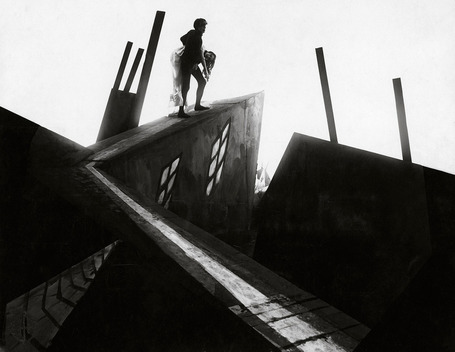Hey!
So, this last week of classes positively defined liberal arts education for me. I went to my Film Music class where we talked about silent movies and the music in them, how music works in a film - does it aid the plot, does it give signs that the rest of a scene doesn't give, is it superfluous or necessary, is it as important as the dialogue, why does the composer use specific instruments, etc. Then, in the next Film Music lecture, we had woman visiting from a local orchestra (called the Club Foot Orchestra) who has done lots of composing work for silent films, from cartoons to more serious films, plus some work with dancers, etc.
In between those two classes, I had one Film lecture during which we talked about silent film and whether music was indeed necessary for film - I never thought about it before. I assumed silent films HAD to have music. Not the case! (In fact, one of the original reasons that there was music was because the old projectors in movie houses were so loud the audience couldn't stand the click-clacking noise, and they needed something to cover it up. But the music that was played didn't always fit the feature - they were live musicians with their own desires - played what they felt like in front of the screen for a bit and eventually got up and left when they felt like it! Often in the middle of the film! Not really what I picture when I think about the early days of cinema...) We also talked about a documentary called The Bronze Screen which is about representations of Hispanic people in Hollywood films (through many eras - the dumb, dangerous bandit, the lawless folks from below the border - women with loose morals, fiery tempered men with twitchy trigger fingers -- all the way to the Latin Lover era ((after too many South American theaters boycotted films that used the tired stereotypes)), then things lapsed back into old habits and they became the villains of Mehico again. But then, near WWII, we wanted to be friends with our neighbors in a serious way, so the government encouraged Hollywood to be much more nice about those folks south of the border, and that's when American audiences came to know the Latin Lovers once again but all in a land of beautiful escapist glory, ruffled dresses, music every night, men dancing with roses in their teeth and women who knew what they wanted and could seduce you with their dark eyes.)
After that class, I went to my "Race, Sexuality and the State" class where we're mostly still on the Race part - and all of the information I had gained from the documentary came zooming back into my mind. After that, my second Film class of the week happened where we watched The Cabinet of Dr. Caligari - a silent film from 1919 with a score composed and performed by The Club Foot Orchestra. !!!
I have to ramble about Caligari a bit just because I was so blown away by the film. The Cabinet of Dr. Caligari (Das Cabinet des Dr. Caligari, actually) is a prime example of German Expressionism. Expressionism is a trend that was also present in the other arts - a movement to not necessarily portray the world as it really is in paintings, photographs, etc. Expressionism brought in the idea that the artist's vision could alter reality, that things could look maybe strange or unreal because it was one person's perception of reality that was being shown. The first people to ever bring this style into cinema were German, which is why the movement is called German Expressionism. In Caligari, the Expressionist trends are marvelously clear - everything was shot on an indoor set with geometrically shaped furniture, actors had incredibly dark eye makeup and faces that were painted white to emphasize the difference in the shades, shadows were painted on the set instead of being caused by real light because the creators wanted them to be a certain way - a cleric of the state in the movie is placed on a chair that holds him five feet above the ground to represent his position in comparison to those around him, etc. It is the first example of a horror film and first film credited with having a twist ending. I won't ruin it though it's hard not to, but boy, go watch it. Please. (it's on instant view on Netflix!)
Now, for someone of my generation, one of the most intriguing things was when the movie started and I saw such images as:
I felt myself getting the chills in a familiar way - all of us students were looking around, unsure. We started whispering to one another -- "Doesn't that -- doesn't it look like a Tim Burton film???" The professor heard us, smiled and said "Yes, Tim Burton. That man has made his life from German Expressionism!"
To have that film in front of us and that kind of stylistic intensity, plot twisting and just damn creepiness was incredible. So far, so good with these class choices this semester.




No comments:
Post a Comment